Sliding Door – Measurement
TRACKS
Our security doors have top and bottom rollers. Flyscreens have bottom rollers only. Your bottom track must have a rig/guide at the center so the rollers can run without fall off. If not, you need to purchase tracks set from us to accommodate the rollers.
METHOD
1. Measuring for a new screen door:
Door Height: Measure lengths at three to four points along the track; each time, take measurement from the top/inside of the top track, to the top/exterior of the bottom track, record the numbers and enter the shortest number to the corresponding height text fields. The door size will be auto calculated and recorded to our system.
If you are not using our PRODUCT BUILDER and are using our fast-track ordering pages, you must calculate the door’s MAKING SIZE by deducting 8mm for bottom wheels-only installation and 15mm from top and bottom wheels installation from the opening height measurement. Please only provide us with the calculated size for fabrication.
All the products listed on the PRODUCT BUILDER page will calculate the size automatically for you, you need to select “from scratch” during the build and enter the measure opening size. The page will calculate and record the making size for you.
If the product you are viewing does not have the word “BUILDER” in this product title, it is the fast-track ordering page. It is designed to order multiple products quickly and for users who ordered from us before.
There are two track systems widely adopted in Australia, one called U shape bottom track and one called open button track; illustrated as below:
Situation 1. U shape bottom track

Situation 2. Open bottom track
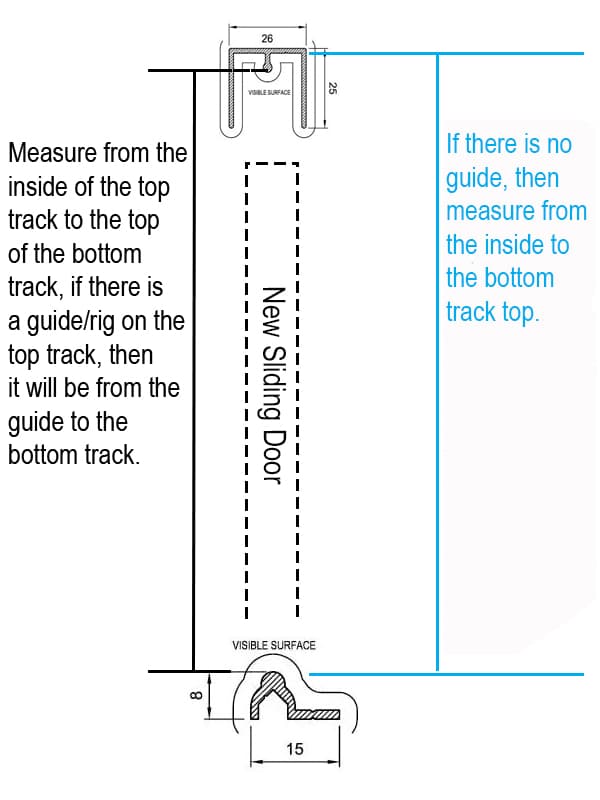
After you measured the height of different location, please check if the numbers are the same. If a variation of more than 4 mm, it means the tracks are not leveled. Some additional adjustment may be required during installation, still enter the smallest height and contact us if encounter any issues during the installation.
Door Width:
The screen door width in general is the same as the sliding glass panel width.
Single Sliding Panels:
Please measure the width of the sliding glass panel and use its width, from the edge of the aluminium frame on one side to the edge of the frame on the other side as the opening width and enter the number into the width field..
Please measure the width three times, top, middle and bottom and record the number in each field.
Stacker Doors/ Multiple Panel doors:
Please measure the width of each sliding glass panel, from exterior edge to the other edge, and record three measurements and enter the numbers into the corresponding width fields.
Information About Interlocks
Frame Interlocks are supplied with all Sliding Security Screen Doors; flyscreen doors are supplied with a side bug seal.
The purpose of interlocks is to lock the back of the sliding door into the fixed panel simultaneously as the door is closed into the locking position, this ensures that the door is locked on both sides, see illustration below.
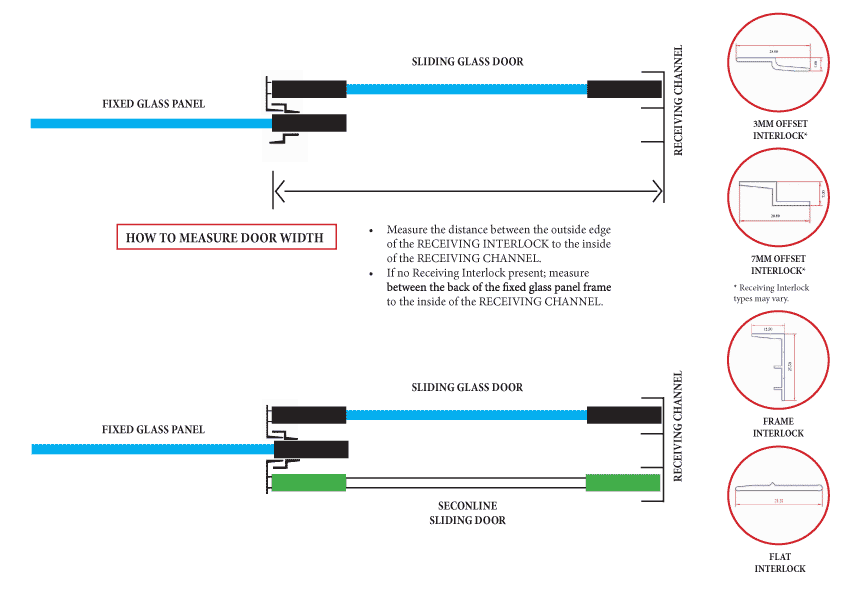
A frame interlock is fixed to the back of the sliding door at the point of installation so as to have it interlock with the receiving interlock which is located on the fixed glass panel.
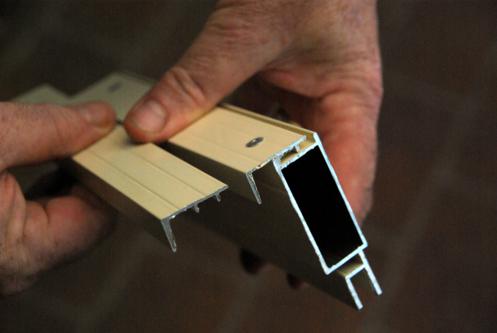
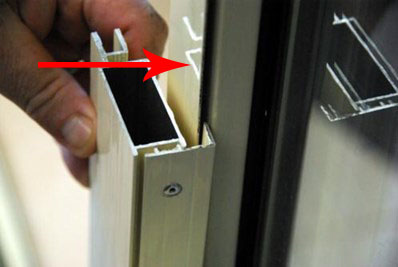
As illustrated in the diagram above, the purpose of the interlock of the screen is to lock in to the receiving interlock on the glass door. However not all glass door has receiving interlock installed.
No Receiving Interlock?
There are two solutions:
- 1. Substitute the frame interlock for a bug seal this will eliminate insects coming from through the gap between the door and fixed panel – indicate this change when placing your order, frame interlock is supplied with all Security Sliding Doors and bug strip is supplied with all flyscreens by default.
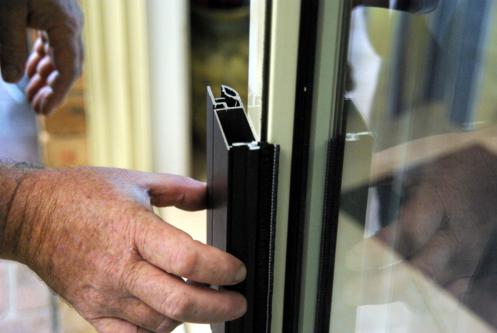
- 2. Purchase and install a receiving interlock; refer to the instruction below.
Need to install Receiving Interlocks?
If your doors do not have receiving interlocks on the fixed glass panel and it is necessary for you to install them there are three different sizes receiving interlocks:
- 7 mm
- 5 mm
Identifying precisely which receiving interlock is most suitable to your doors can be using the following methods:
The illustration bellow shows where to measure.
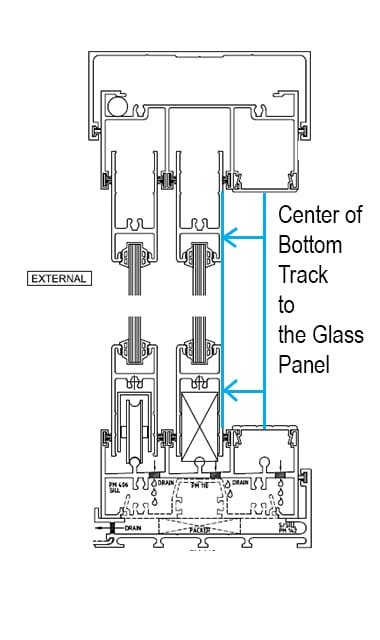
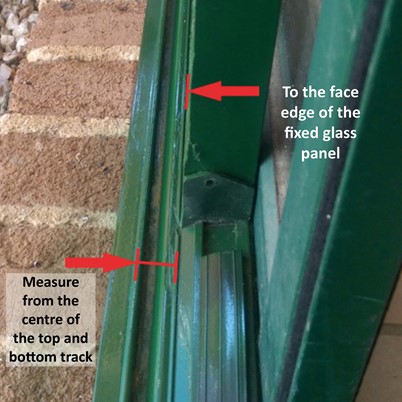
If the distance from the centre of the bottom track to the face edge of the fixed glass panel is greater than 20 mm then a 7 mm offset interlock is required.
If the distance from the centre of the bottom track to the face edge of the fixed glass panel is less than 20 mm and greater than 16 mm then a 5 mm offset interlock is required.
Lock Height:
Lock Above: Measure from the top of the bottom track to the top of the existing sliding door lock or handle, and record the number.
Lock Below: Measure from the top of the bottom track to the bottom of the existing sliding door lock or handle, and record the number.
Lock Side:
Viewing from outside, identify which side the glass door handle is located.
Lock Type:
Security sliding door will require steel key lock for security purpose. Flyscreens can have key lock, plastic latch, or handle, since security is not a concern for flyscreen doors.
2.Replacing the existing door:
Door Height & Door Width: We generally recommend you to measure the size of the existing doors, if you are happy with how the door is. The new door will be exactly the same. If you are not happy about the size, you need to follow the above step and choose build from scratch.
Lock Height:
Lock Above: Measure from the bottom of the exisitng door to the bottom of the exisitng lock and enter the number. the new lock will be installed above this point.
Lock Below: Measure from the bottom of the exisitng door to the top of the exisitng lock and enter the number. the new lock will be installed below this point.
Lock Side:
Viewing from outside the house, identify which side the original door lock is.
Lock Type:
Security sliding door will require key lock, flyscreen door can choose any type that best fit your needs.


